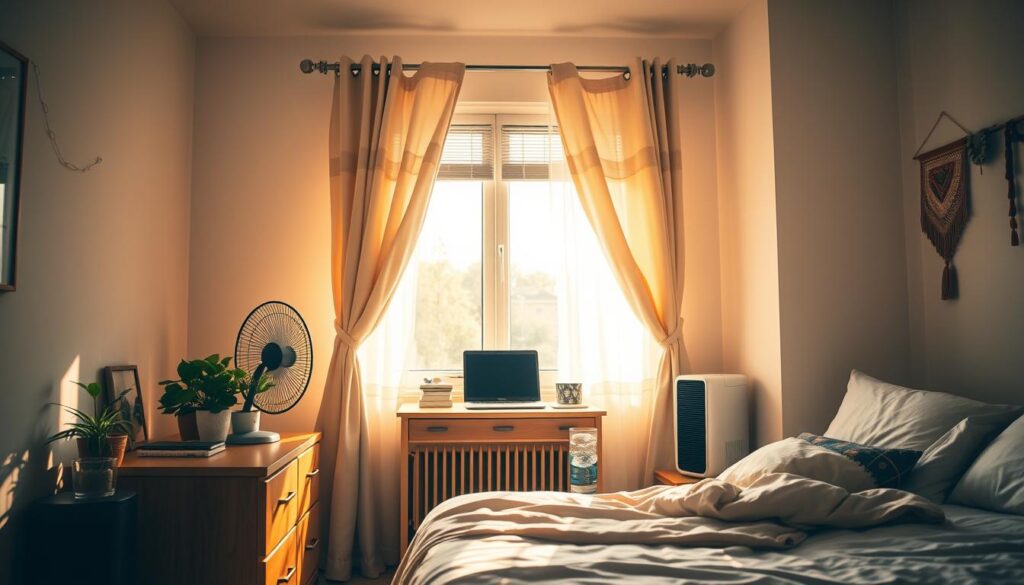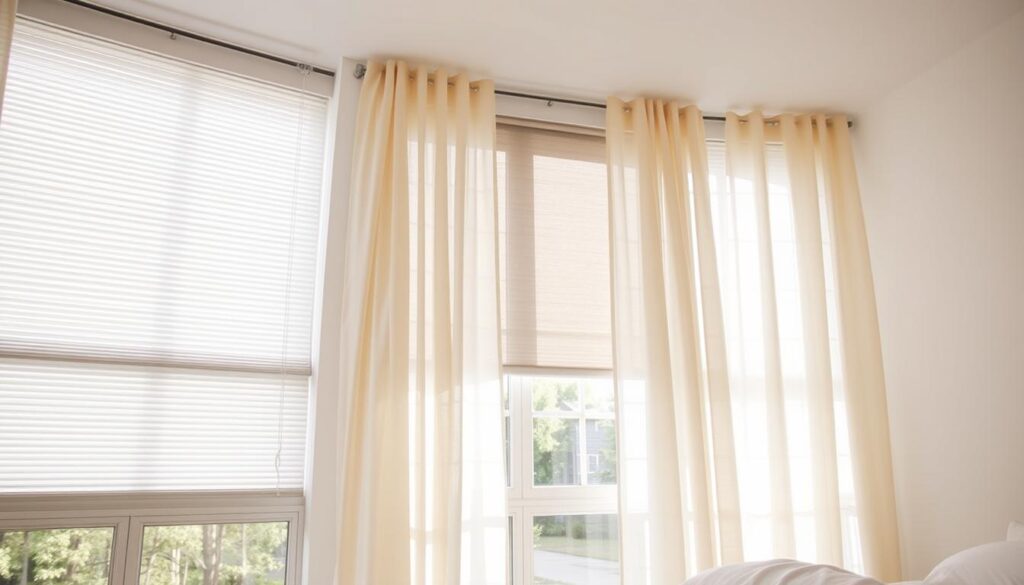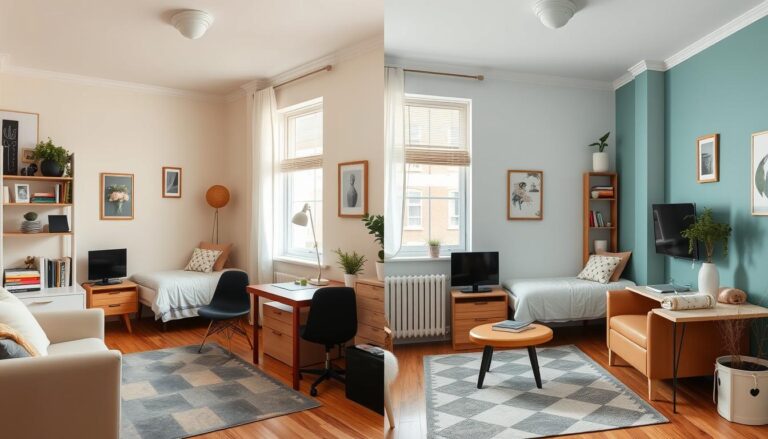How to keep your dorm cool in the summer without AC
Discover effective tips for keeping dorm cool without air conditioning. Learn simple strategies to stay cool in your dorm room this summer.
College living spaces often turn into sweltering zones during hot weather. Small rooms with limited airflow trap warmth from electronics, sunlight, and body heat. The National Institutes of Health warns that prolonged exposure to high temperatures can cause dehydration, reduced focus, and even organ stress.

Humidity worsens these conditions by preventing sweat evaporation – the body’s natural cooling system. Students juggling classes and late-night study sessions need restful sleep, but sticky sheets and stuffy air make it hard. Older campus buildings rarely offer individual climate controls, forcing creative problem-solving.
This guide shares science-backed methods to manage your space efficiently. You’ll learn how airflow patterns, reflective materials, and smart scheduling create cooler environments. These solutions work with basic supplies like fans, curtains, and reusable ice packs.
Key Takeaways
- Prolonged heat exposure risks health issues like dehydration and heat exhaustion
- Small spaces trap warmth from electronics, sunlight, and poor ventilation
- Humidity blocks natural cooling through sweat evaporation
- Strategic airflow adjustments can lower perceived temperature
- Budget-friendly tools like fans and thermal curtains offer immediate relief
Identifying the Challenges of Dorm Room Heat
Overheated living areas create more than discomfort – they disrupt basic biological functions. When the body can’t shed excess warmth through sweating, core temperature rises dangerously. This biological reality collides with architectural limitations in student housing.
Understanding the Impact of Heat on Health
Sleep quality plummets when heat prevents natural temperature drops. Studies show people take 14 minutes longer to fall asleep in warm rooms. Prolonged exposure risks heat exhaustion symptoms like nausea and rapid pulse.
Students face unique risks. All-night study sessions and shared space conditions amplify thermal stress. Dehydration from poor hydration habits worsens these effects.
What Else Would You Like to Know?
Choose below:
Common Factors That Make Dorms Overheat
Multiple heat sources converge in student rooms. Electronics emit warmth even in standby mode – laptops add 80-100 watts per hour. Mini-fridges pump out heat while cooling contents.
Building design often compounds issues. Many residence halls lack shaded windows or attic insulation. Upper-floor units trap rising warm air, creating temperature differentials of 10°F between floors.
Natural Ventilation and Airflow Solutions
Harnessing natural airflow patterns offers cost-free temperature regulation for confined spaces. Strategic window use transforms stagnant environments through physics-driven circulation – no plugs or remotes required.
Mastering Cross-Breeze Dynamics
Opposing windows create pressure channels that flush out warm air. Research shows this method reduces indoor temperatures by 5-8°F when outdoor conditions permit.
“Cross-ventilation effectiveness peaks when exterior temperatures dip below 70°F,”
notes the Building Science Corporation.
Optimal timing follows daily thermal rhythms:
| Time | Action | Impact |
|---|---|---|
| 5-8 AM | Open north/east windows | Captures cool morning air |
| 10 AM-4 PM | Close all openings | Blocks heat gain |
| 7-10 PM | Create diagonal airflow | Expels accumulated warmth |
Upper-floor residents should open high windows to exploit rising heat. Combine with box fans facing outward to accelerate breeze movement. Nighttime ventilation proves particularly effective – outdoor temperatures often drop 15°F after sunset.
Students in corner units can orchestrate building-wide airflow. Coordinate with neighbors to open hallway windows and stairwell exits. This creates a chimney effect, pulling fresh air through multiple rooms simultaneously.
Effective Strategies for keeping dorm cool without air conditioning
Strategic airflow management transforms stifling spaces into livable environments. Physics-driven methods outperform basic fan use when applied correctly.
Window Exhaust Tactics That Work
Reverse fan direction for better results. Box fans placed outward in sealed windows create negative pressure. This pulls fresh cold air through secondary openings.
Follow this 3-step process:
- Fit fans tightly in north-facing windows using cardboard spacers
- Open another window at least 4 feet away
- Run exhaust fans during cooler evening hours
“Properly sealed window fans remove 30% more warm air than standard setups,”
states a University of Michigan thermal dynamics study.
Building a Directed Airflow Network
Coordinate multiple units for enhanced cooling. Upper-floor residents should position exhaust fans high, while lower floors maintain intake windows. This creates a vertical air current through the building.
| Fan Type | Placement | Effect |
|---|---|---|
| Box fan | Window exhaust | Removes warm air |
| Tower fan | Room center | Distributes cooled air |
| Clip fan | Bedside | Personal cooling |
Seal gaps around fans with foam weatherstripping. This simple fix boosts airflow efficiency by 40%. Students report 5-8°F temperature drops using this method overnight.
Blocking Out the Heat: Curtains, Blinds, and Sun Shields
Window treatments serve as the first line of defense against solar heat invasion. Up to 76% of sunlight entering through glass converts to warmth, according to the Department of Energy. Proper coverage during peak hours prevents this energy from overheating your space.

Choosing the Right Window Treatments
Blackout curtains outperform standard options by blocking 99% of visible light and 85% of thermal energy. Their multilayered design creates an insulation barrier, reducing temperature spikes by up to 15°F. Pair them with adjustable blinds for flexible light management.
Follow these guidelines for maximum effectiveness:
- Close coverings before 10 AM on east-facing windows
- Use white or silver linings to reflect sunlight
- Extend curtains 6 inches beyond window frames
| Treatment Type | Heat Reduction | Light Control |
|---|---|---|
| Blackout Curtains | 85% | Complete |
| Solar Shades | 65% | Adjustable |
| Aluminum Blinds | 45% | Partial |
The Amazon Basics Room Darkening Blackout Window Curtains offer budget-friendly performance, blocking 100% of sunlight when fully closed. Install them on south and west-facing windows first – these directions receive 80% of daytime solar radiation.
“Properly installed window treatments can reduce cooling costs by 25% in summer months,”
notes a recent Cornell University housing study. Keep coverings closed until outdoor temperatures drop below indoor levels, typically after 7 PM in most regions.
Cooling Technologies: Fans, Light Bulbs, and Energy Efficiency
Smart device selection amplifies cooling efforts in compact environments. Proper equipment choices tackle heat buildup at its source while improving comfort levels.
Strategic Fan Selection and Positioning
Three fan categories serve distinct roles in temperature management. Box models like the Lasko 3300 excel at moving large air volumes through windows. Tower units such as the Honeywell QuietSet circulate currents in tight spaces without dominating floor areas.
| Type | Best Use | Noise Level |
|---|---|---|
| Box Fan | Window exhaust | Moderate |
| Tower Fan | Room circulation | Low |
| Desk Fan | Personal cooling | Variable |
Position units to create air highways. Place box fans facing outward in north-facing windows during evenings. Angle tower fans toward seating areas for direct relief. The Vornado Pivot’s 90-degree rotation makes it ideal for study desks.
Lighting Upgrades for Heat Reduction
Traditional bulbs waste 90% of energy as heat. Switching to LEDs near workspaces cuts this thermal output by 75%. Focus changes on fixtures used for hours daily – desk lamps and bedside lights deliver the most noticeable improvements.
- Replace bulbs within 3 feet of seating areas first
- Choose 9-12 watt LEDs for task lighting
- Use dimmable options to reduce energy use further
While lighting changes won’t transform room temperatures, targeted upgrades create localized comfort zones. Combined with proper fan use, these adjustments help maintain bearable conditions during heat waves.
Creative In-Room Adjustments for a Cooler Environment
Layout modifications can transform stagnant areas into breezy retreats. Spatial dynamics influence thermal comfort more than most students realize – a well-organized room feels 7-10°F cooler than cluttered spaces.
Rearranging Furniture to Enhance Airflow
Position beds and desks perpendicular to windows. This creates natural channels for air movement. Avoid pushing large items against walls with vents or intake sources.
Close doors to unused spaces during peak heat hours. Isolating occupied areas prevents cooled zones from dissipating. Bathrooms and closets often become unnecessary heat traps.
| Problem Area | Solution | Impact |
|---|---|---|
| Blocked window | Move bookcase 3ft left | 25% airflow increase |
| Cluttered floor | Install wall shelves | Reduces surface heat |
| Closed kitchen door | Run exhaust fan | Removes 60% cooking heat |
Elevate storage to maintain clear floor paths. Items under beds disrupt air circulation patterns. Use vertical organizers for clothes and supplies instead.
“Proper furniture placement reduces perceived temperature by creating psychological and physical cooling effects,”
Flip bathroom fans on for 30 minutes post-shower. This simple habit removes steam that could raise humidity levels. Kitchen exhaust systems work similarly for oven heat containment.
Smart Bedding and Additional Comfort Tips
Quality sleep becomes crucial during summer semesters when heat disrupts rest cycles. The right bedding choices and evening routines create microclimates that support thermal regulation – even in challenging environments.
Selecting Breathable Bedding Options
Natural fibers outperform synthetic materials in humidity control. Cotton and linen sheets allow 35% more airflow than polyester blends. Bamboo-derived fabrics offer moisture-wicking properties, pulling sweat away from skin within minutes.
Consider these upgrades:
- Gel-infused mattress toppers absorb body heat
- Buckwheat pillows resist heat retention
- Wool blankets stabilize temperatures
Nighttime Cooling Techniques
Pre-chill bedding using sealed ice packs 30 minutes before bed. Place them between sheets and mattress pads for gradual cooling. The Brooklinen Linen Core Sheet Set demonstrates how tight weaves enhance breathable bedding performance without trapping warmth.
Strategic shower timing helps too. A 2-minute lukewarm rinse 90 minutes before sleep triggers the body’s natural cooling response. Pair with a small desk fan angled across damp skin for accelerated evaporation effects.
FAQ
What window treatments work best to block sunlight?
How can I improve airflow in a small space?
Do LED bulbs really help lower room temperatures?
What bedding materials stay cool during hot nights?
How does furniture arrangement affect room temperature?
Can outdoor weather patterns impact indoor cooling strategies?
Are portable evaporative coolers effective for small rooms?
The Best Colors to Make Your Student Apartment Feel Bigger
» See exclusive tips for your home








